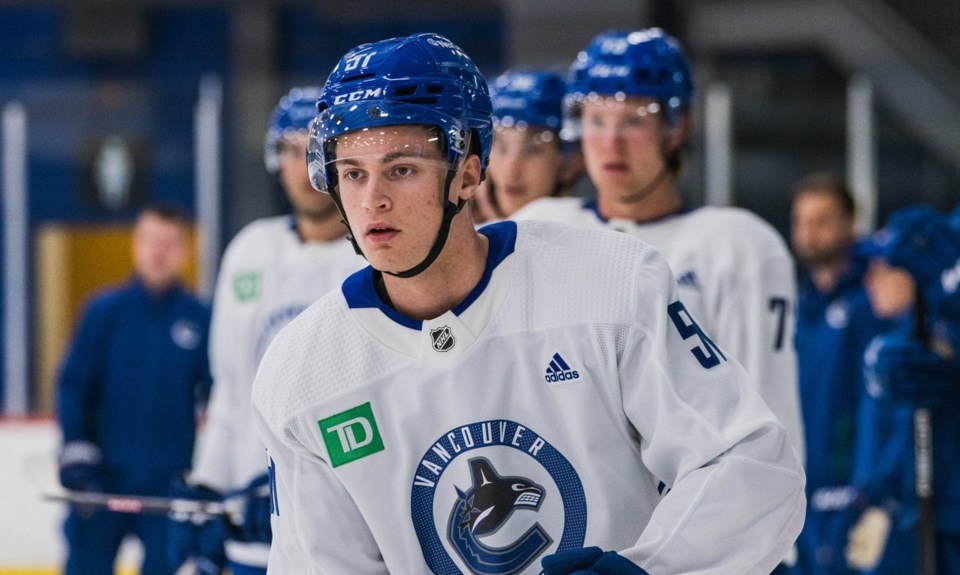It is readily apparent from talking to Tom Willander that he is smart, driven, and passionate.
It was also apparent from how long it took for Willander to come talk to the media on day one of the Vancouver Canucks’ prospect development camp. The 11th-overall pick in the 2023 NHL Entry Draft was the last of the prospects to leave the gym from the team’s off-ice workouts after their on-ice sessions. It was a long, physically-demanding day but it seemed like Willander didn’t want it to end.
Willander is eager to absorb everything he can at his first NHL camp, even paying careful attention to the skills being taught to the forwards as they worked on one-on-one drills.
“I'd say generally a lot of the skills the forwards do are very transferable to D because I feel like in today's hockey, Ds have to be very skilled,” said Willander.
He would know. Up until two years ago, Willander was a forward — this past season was just his second full season as a defenceman. Getting picked 11th overall in a position he still has limited experience in is quite the feat and suggests he has a lot more room to grow.
“There’s a ceiling in inexperience, just in different situations on the ice that I feel like could definitely be worked on,” said Willander. “Last season had a lot of games and I felt like that helped me a lot, just getting used to it.”
"It makes it easier to understand what the forwards feel."
According to Scott Atkinson — the former coach for Canucks prospect Akito Hirose, who made a similar switch from forward to defence — the difference in skillset between a high-end forward and defenceman is minimal. The real difference is in their perspective on the ice: how they view the game.
“It’s dealing with the cognitive aspect of the game or the neuroscience of the game — that decision-making, spatial orientation, navigation, all that kind of problem-solving, perceptual stuff that everybody refers to, in simple terms, as hockey IQ,” said Atkinson. “Basically, the way I put it is when you’re playing the game, is it like you’re on TV, one of the actors in the play? Or is it like you’re in the audience watching the play or watching on TV.”
In other words, forwards are at their most comfortable when they actively lead the play, while defencemen are at their most comfortable when they’re watching the play, seeing everything unfold in front of them.
Willander immediately agreed with the idea that it’s primarily a change in perspective as he moved from forward to defence.
“One hundred per cent,” he said and added one of the main benefits in playing from being the play: “I feel like it’s easier to know what situations you’re putting your forwards into with different passes.”
Willander also leans into his experience as a forward to influence how he plays as a defenceman. He gave an example of not wanting, as a forward, to receive a pass ringed around the boards while under pressure.
“Not too fun when you’ve got a 200 pound guy on your back,” said Willander with a grin. “It makes it easier to understand what the forwards feel.”
"A bit more physical but I like it."
Willander primarily focused on the defensive aspect of the position this past season and he quickly developed into one of the premier stoppers of his draft class, using his exceptional mobility to close on opposing forwards and force them to the outside. He wasn’t afraid to get physical either, something he says will be easier on the smaller ice in North America, where he’ll be playing at Boston University next season.
“I feel like the small rink makes it a little bit higher pace than it would be on the big rink, a bit more physical but I like it,” said Willander. “Sometimes, it’s a bit harder on the bigger ice because players have more space when they have the puck, so I feel like [on the smaller ice], it’s closer to get somebody stuck on the boards.”
As Willander absorbs as much as he can at his first camp, he gave an interesting answer when asked what he hopes to get from the Canucks.
“I’m hoping that they give me the same passion that I’m willing to give them,” said Willander. “I really like this place and, obviously, they took a first-round pick to get me here. I want to make a difference here. Hopefully, they return that and give me opportunities.”
With his rapid development and competitive nature, Willander won’t have to wait long for those opportunities. In fact, the Canucks won’t have to give Willander any opportunities at all — he’ll take them.




